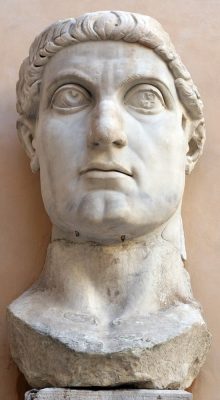The Colossus of Constantine was a giant statue of the Roman Emperor Constantine I (also known as Constantine the Great), originally erected in the western apse of the Basilica of Maxentius and Constantine (or the “Basilica Nova” as it was later called). It was made of marble and bronze and measured approximately 12 meters (40 feet) in height. The statue was a massive, towering acrolithic and was presumably erected sometime between 312 and 330.
Background
After Constantine defeated Maxentius at the Battle of the Milvian Bridge in 312, he decided to complete the construction of the Basilica of Maxentius but with some changes. Constantine reoriented the building, changed the site of the principal entrance, and added a new northern apse. He also erected a giant statue of himself in the west apse, which publicly and visibly declared his overthrow of Maxentius. The giant statue, which came to be known as the Colossus of Constantine, had an inscription that read, “I rescued your city and freed it from the tyrant’s yoke.”
However, the entire Colossus has not survived to our present day. Because the Colossus had body portions made of bronze, it was a tempting target for thieves. Only fragments of the marble portion have survived to our present day, including the head and the neck, an arm, a knee, a right hand, and a left foot. Some surviving remnants were moved from the Basilica to the nearby Palazzo dei Conservatori Courtyard by well-known Italian painter, sculptor, and architect Michelangelo Buonarroti (1475-1564). In 1951, the left breast and right arm of the Colossus were discovered. Today, the remnants of the Colossus can be viewed at the Capitoline Museums in Rome.
Physical Description

The Colossus of Constantine was originally a seated figure of an emperor, as indicated by the position of the left foot with the heel raised. The statue was bare-chested and was probably placed on a pedestal. The exposed flesh of the body was portrayed in white marble, while the mantle was likely made with bronze. Constantine’s statue might have been wearing a diadem or some other form of imperial headgear, as suggested by the dowel holes on his temples. His eyes were looking upwards, and his face was youthful and beardless. Constantine’s other body parts, such as the arms and feet, were sculpted in a naturalistic style and crafted with maximum detail. The statue’s right hand could have possibly held a staff with a Christian symbol, such as the Chi-Rho, which stands for the first two letters of the word Christ in Greek (ΧΡΙΣΤΟΣ).
The Colossus of Constantine was a symbol of his power and victory. As such, it was designed to be visible from far away and to awe the beholders. Constantine’s reign marked the rise of Christianity and Christian values over paganism in Rome. The Colossus, therefore, served as a constant reminder to Romans that they must embrace the new faith brought by the emperor.
